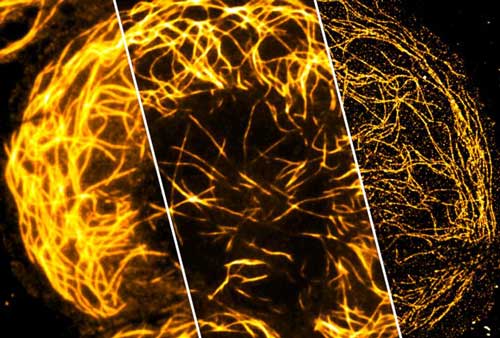| Posted: Apr 24, 2017 |
Chip-based nanoscopy: Microscopy in HD quality
(Nanowerk News) In nanoscopy, the position of single fluorescent molecules can be determined with a precision of just a few nanometres. This information can be used to produce images with a resolution of about 20 to 30 nanometres, and thereby ten times that of conventional light microscopy. Until now, this method has required the use of expensive special instruments. Bielefeld University and the University of Tromsø have filed a patent for this new 'chip-based nanoscopy' procedure. The study has been published in Nature Photonics ("Chip-based wide field-of-view nanoscopy").
|
 |
| New imaging potential: Standard resolution (left) compared to (center, right) high resolution and super-resolution obtained with the chip-based technique. (Image: Bielefeld University/Robin Diekmann) (click on image to enlarge)
|
|
Physicists at Bielefeld University and the Arctic University of Norway in Tromsø have developed a photonic chip that makes it possible to carry out superresolution light microscopy, also called 'nanoscopy', with conventional microscopes.
|
|
Dr. Mark Schüttpelz from Bielefeld University and Dr. Balpreet Singh Ahluwalia (University of Tromsø) are the inventors of this photonic waveguide chip. Professor Dr. Thomas Huser and Robin Diekmann from Bielefeld University's Biomolecular Photonics Group also worked on developing this new concept.
|
|
Whereas the images that can be obtained simultaneously with established nanoscopy techniques range from only parts of cells up to just a few cells, the use of photonic chips now makes it possible to visualise more than 50 cells in one superresolution image. 'The invention of the new chip-based superresolution technique is a paradigm shift in microscopy, and it will now permit a much broader use of nanoscopy in science, research, and everyday applications,' says Dr. Mark Schüttpelz.
|
|
Current nanoscopic techniques are extremely complex, expensive, and require intensively trained technicians. Up to now, these limitations have restricted the use of nanoscopy to only highly specialized institutes throughout the world and prevented its spread to standard laboratories in biology and medicine let alone to hospitals and analytical laboratories.
|

